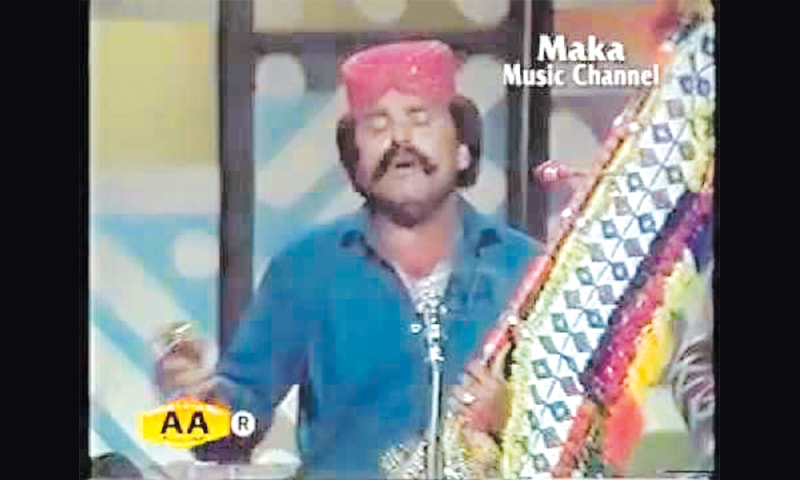Music in Sindh displays diverse forms, trends and styles of performance, instruments, context, content and repertoire. It also embraces various song styles, musician families and traditions such as ceremonial, classical, semi-classical, folk and Sufi music schools. There are thus many singers, musicians and instrumentalists associated with these particular styles and forms.
Some musicians, being incredibly popular owing to their distinctive contribution and charisma, have created a massive following, in the process themselves becoming folk heroes and icons of Sindhi music.
With his distinct style of musical performance, Jalal Chandio has been a prominent folk singer among the rural masses of Sindh over the past three decades. He contributed to and popularised the peculiar tradition and style of singing by using the Yaktaaro (rod-like one-string instrument) and Chappryun (hand clappers), a style that was already popular at Sufi Shrines. Chandio further developed this style and introduced it to the genre of folk music.
Born in 1944 in the village of Moro, District Naushahro Feroze, Jalal Chandio was inclined towards music since an early age. His father sent him to learn tailoring, but young Chandio’s soul drove him towards singing. He would listen to songs on the radio and visit the annual festivals held at saints’ shrines, an integral part of rural Sindhi society and culture.
Jalal Chandio’s images on trucks and his songs playing on tractors is a tribute to him from fans who love his unique style of folk singing
During the ’70s, Jalal Chandio debuted as a novice singer, soon becoming popular with his vocal style, performance, selection of expressive poetry, narration of romance and use of instruments that later became associated with him. With his powerful voice and poetic expressions, he became a trend-setter in Sindhi folk music. He introduced the concept and trend of Farmaish — a peculiar style of narrating the names of listeners as they listened to their names in his songs — thus reciprocating, and garnering even more appreciation.
Previously, the rural population used to listen to Indian film music and Pakistani Punjabi singers such as Madam Noor Jehan and Inayat Husain Bhatti but with his rise in popularity, Chandio’s songs were played on tractors and trucks, providing entertainment and relief for labourers with long and hectic work schedules.
Chandio would be invited to sing at weddings and other festive occasions. His performances at the grand annual festivals of saints’ shrines such as Shah Abdul Latif Bhitai, Sachal Sarmast, Saman Sarkar, Ranipur and Khairpur Nathan Shah would attract large audiences.
In the ’80s, Paras, a music recording company in Hyderabad became the brand name for Jalal’s audio albums and the sale of his tapes led to a historic sale of Sanyo and National tape recorders in rural Sindh.
A large number of new singers who were influenced by Jalal Chandio’s musical style emerged, many of them being Chandio’s shagirds (students). Rubina Hyderi and Taj Mastani, two popular folk female Sindhi singers also adopted Jalal’s style of Yaktaaro and Chappryun. His popularity spread to Seraiki districts in Punjab and the border districts of Balochistan.
Chandio sang the works of rural poets which were representative of our indigenous culture. His music played an important role in the preservation and promotion of the Sufi poetic heritage as he rendered the mystic kalaam of Shah Abdul Latif Bhitai, Sachal Sarmast, Khawja Ghulam Fareed, Bulleh Shah and many other Sufi poets. During the peak of Sindhi nationalism in the ’80s, Jalal sang nationalist songs too.
Chandio passed away on Jan 10, 2001 in a hospital in Karachi. Jalal’s folk music tradition and style is symbolic of love, romance and rebellion; his legacy and heritage offer rich cultural context for students and ethno-musicologists. The rural landscape of Sindh is incomplete without Jalal Chandio’s images on trucks and his ever-popular music and songs playing in the fields, tractors, eating places and homes.
Published in Dawn, Sunday Magazine, February 1st, 2015
On a mobile phone? Get the Dawn Mobile App: Apple Store | Google Play

















































